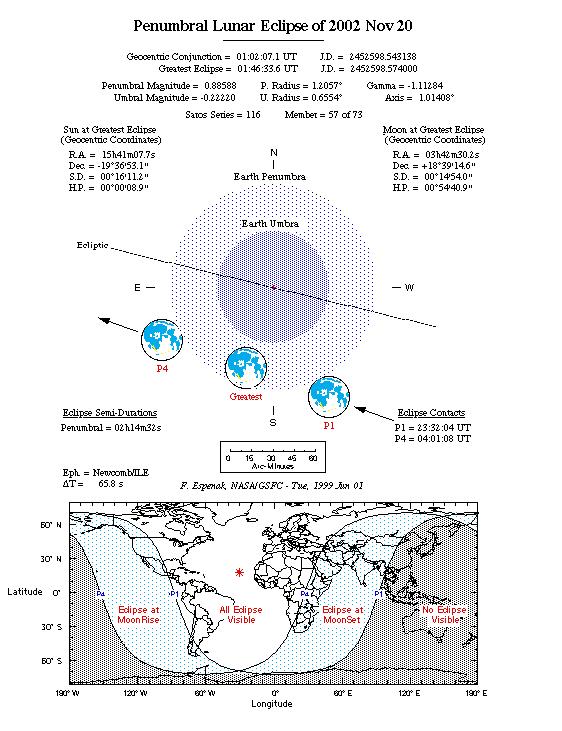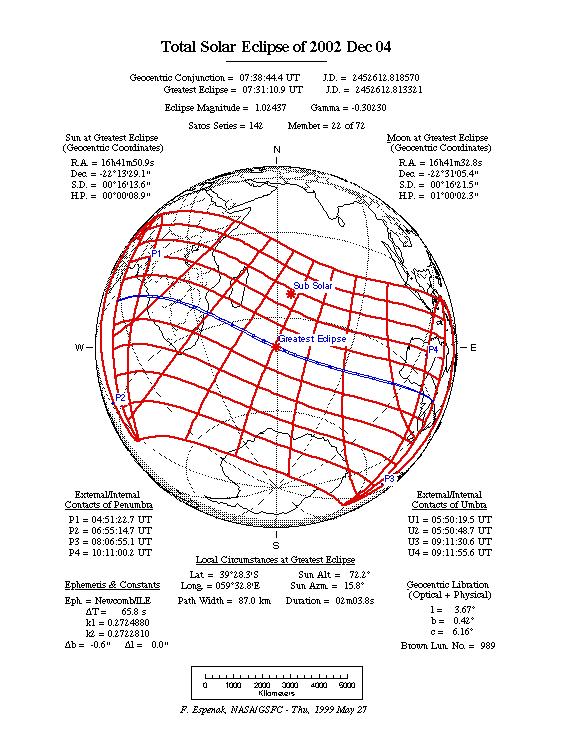
The eclipses:- November and December 2002.
Astronomical info on this page from...... http://sunearth.gsfc.nasa.gov/eclipse/OH/OH2002.html
Penumbral eclipse of the Moon
The Penumbral Lunar Eclipse
November 20th 2002.
This penumbral lunar eclipse occurs at 27 degrees Taurus, (the Halloween Full Moon). The Sun Moon opposition is squared by Uranus, which on first inspection appears to suggest a difficult and slightly shocking 'atmosphere'. Further analysis reveals a wealth of trine aspects allowing some ease of expression. Jupiter is trine Pluto (in Fire signs), and Saturn is trine Uranus (in air signs). Venus is trine Saturn and Mars is applying in trine aspect to Uranus.
At the time of maximum eclipse in London the Sun and Moon form a 'mystic rectangle' with the local Ascendant and Mid heaven. Once again this year it appears that the UK is in major focus in world events during the period . The eclipse Moon rises over Pakistan. Neptune is at lower culmination at Baghdad, Mars rises at Ankara and Cairo. Saturn risen at Aspen USA.
The eclipsed Moon is conjunct the natal Sun of Israel and also conjunct the natal Moons of the Pope, Vladimir Putin and Ariel Sharon.
The Moon is conjunct natal Jupiters in both Tony Blair astrological chart and that of the the UK Labour Party.
November 20th 2002.
The last penumbral lunar eclipse of 2002 is also the deepest lunar eclipse of the year. The event will be observable from the Americas, Europe, Africa and central Asia. First and last penumbral contacts occur at 23:32 UT (Nov 19) and 04:01 UT (Nov 20), respectively At greatest eclipse (01:47 UT), the penumbral magnitude reaches its maximum value of 0.8862 as the Moon's northern limb passes just 6.6 arc-minutes from the edge of the umbra. Observers should be able to see a subtle yet distinct shading across the northern portion of the Moon's disk. Alas, the striking colors present during total eclipses will be absent from this event. We must wait until 2003 when two total lunar eclipses take place.

The Total Solar Eclipse December 4th 2002
The Total Solar Eclipse on Wednesday December 4th at 12 degrees Sagittarius reaches its maximum point at 07-38 GMT. The Sun and Moon are sextile Neptune and weakly conjunct Pluto. Dominating all astrological moments this season Jupiter is trine Pluto and Saturn is trine Uranus. Venus and Mars are conjunct in early Scorpio, Mercury in late Sagittarius is sextile Uranus and is opposite Saturn. No planet is in an earth sign or a cardnial sign.
At the moment of greatest eclipse at London, where Sagittarius rises, Mercury and Saturn form a mutable T-Square with the Mid Heaven. The Sun and Moon there are exactly on both the Uranus MidHeaven midpoint and the Mercury Ascendant midpoint.
The Sun and Moon are exactly rising at Stugart, Berne, Berlin and Barcelona. The Sun and Moon are on the Mid Heaven of Bombay. Mercury is rising at Moscow. Mars is conjunct the Mid Heaven of Harare and at Kabul, Uranus rises.
The final event of the year is a total solar eclipse visible from a narrow corridor that traverses the Southern Hemisphere. The path of the Moon's umbral shadow begins in the South Atlantic, crosses southern Africa and the Indian Ocean and ends at sunset in southern Australia. A partial eclipse will be seen within the much broader path of the Moon's penumbral shadow, which includes most of Africa, western Australia and Antarctica The eclipse begins in the South Atlantic where the Moon's umbral shadow first touches down on Earth at 05:50 UT Along the sunrise terminator, the duration is only 26 seconds as seen from the centre of the 31 kilometre wide path. Seven minutes later, the umbra reaches the Atlantic coast of Angola (05:57 UT). Quite coincidentally, the first track of Angolan land to experience totality was also within the path of the total solar eclipse of 2001 June 21. The local residents are indeed fortunate to witness a total eclipse twice within the span of eighteen months. The early morning eclipse lasts 51 seconds from the center line with the Sun 19° above the horizon. The umbra carves out a 50 kilometre wide path as it sweeps across Angola in a southeastern direction. Briefly straddling the Angola/Zambia border, the shadow crosses eastern Namibia before entering northern Botswana (06:09 UT). The path width has grown to 60 kilometres and totality lasts 1 minute 11 seconds. Following the political boundary between Zimbabwe and Botswana, the umbra travels with a ground speed of 1.2 km/s. Bulawayo, Zimbabwe lies just north of the track and its residents witness a deep partial eclipse of magnitude 0.987 at 06:14 UT. The umbra crosses completely into Zimbabwe before entering northern South Africa at 06:19 UT. One minute later, the northern third of Kruger National Park is plunged into totality which lasts 1 minute 25 seconds as the hidden Sun stands 42° above the horizon. Quickly crossing southern Mozambique, the shadow leaves the dark continent at 06:28 UT and begins its long trek across the Indian Ocean. The instant of greatest eclipse occurs at 07:31:11 UT when the axis of the Moon's shadow passes closest to the centre of Earth (gamma = -0.302). The length of totality reaches its maximum duration of 2 minutes 4 seconds, the Sun's altitude is 72°, the path width is 87 kilometres and the umbra's velocity is 0.670 km/s. Unfortunately, the umbra is far at sea ~2000 kilometres southeast of Madagascar. During the next hour and a half, no land is encountered as the eclipse track curves to the northeast and begins to narrow. In the final ninety seconds of its terrestrial trajectory, the umbra traverses South Australia. The coastal town of Ceduna lies at the center of the 35 kilometre wide path. Totality lasts 33 seconds while the Sun stands 9° above the western horizon. The accelerating ground speed of the umbra already exceeds 5 km/s. In the remaining seconds, the increasingly elliptical shadow sweeps across 900 kilometres of the Australian Outback.
The umbra leaves Earth's surface at the sunset terminator at 09:12 UT. Over the course of 3 hours and 21 minutes, the Moon's umbra travels along a path approximately 12,000 kilometres long and covering 0.14% of Earth's surface area
